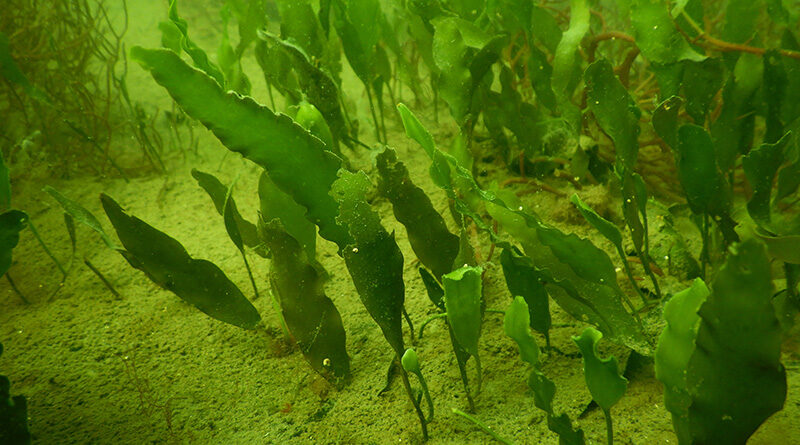Invasive Seaweed Discovered in San Diego Bay
The public is being urged not to drain saltwater aquariums into bays, streams, ponds or storm drains as the rapid-growing invasive species is a threat to ecosystems.
The Port of San Diego, along with the Southern California Caulerpa Action Team (SCCAT), the city of Coronado, and the Coronado Cays Homeowners Association (CCHOA), has announced their response to the discovery of an invasive seaweed scientifically known as Caulerpa prolifera in the Coronado Cays area of San Diego Bay.
A notable characteristic of Caulerpa prolifera is its reproductive strategy. It can reproduce both sexually and asexually. Asexual reproduction occurs through fragmentation, where pieces of the alga (fronds or stolons) can break off and give rise to new growth. This high reproductive potential contributes to its ability to colonize new areas rapidly.
According to the Port of San Diego, Caulerpa is an algae native to Florida and other subtropical and tropical locales. In non-native areas, it can disrupt the ecosystem, superseding native plants and the animals that rely on them. In San Diego Bay, state and federally protected eelgrass habitats are especially at risk as eelgrass is used by native green sea turtles, a threatened species, as well as 70 different fish species that rest within and feed on eelgrass. Caulerpa poses no threat to humans.
Caulerpa is used predominantly in saltwater aquariums. In California, possessing, selling or transporting any Caulerpa seaweed is illegal (AB 655, 2023), and fines can range from $500 to $10,000 per violation.
Divers found a small patch of Caulerpa prolifera in late September while conducting an in-water pre-construction eelgrass/Caulerpa dive survey as required by a permit condition for a dock replacement project. Additional patches were discovered nearby during follow-up surveys. The total find within the Cays is about one-quarter of an acre.
A press release sent out by the Port of San Diego reads:
“The SCCAT has prepared a Rapid Response Eradication Plan to address the immediate need to eradicate this invasive species. This plan includes the following components:
- Control of Infestation Site – To prevent disturbance by boat anchors and boat wakes, the affected areas are being controlled through coordination with the CCHOA and slip occupants.
- Localized Eradication Level Survey – Diver surveys are being conducted within and adjacent to the affected area. Divers locate, record and map any Caulerpa prolifera found.
- Treatment – The Caulerpa prolifera is being covered by trained divers with a sealed barrier that will kill the algae by exclusion from light, oxygen and circulation. This method has been successfully used in the past at other Caulerpa infestation sites in other areas of Southern California.
- Post Treatment Surveys – Diver surveys will be conducted both immediately following treatment and over a longer timeframe to help ensure the species is completely eradicated and does not repopulate the area.
- Broad Area Surveys – Diver surveys will occur in surrounding areas of San Diego Bay to determine if other areas have been invaded.
The estimated cost for the surveys and eradication is to be determined. The Port of San Diego has contributed approximately $92,000 to date. The Port and the U.S. Fish and Wildlife Service have applied for a grant from the Rapid Response Fund for Aquatic Invasive Species to cover the remaining costs. Additional funding from the State Water Resources Control Board’s Cleanup and Abatement Account also may be available; the Port and other parties may be eligible for reimbursement through these funding sources.
Caulerpa can rapidly and aggressively transfer and develop from contact with vessels, fishing equipment, and even tidal exchanges. It is suggested that boaters, kayakers, swimmers and divers avoid the areas or gently transit the channel at high tide to prevent the involuntary spread of this invasive species.
The Port believes that the most likely source of this infestation is the release from a saltwater aquarium into the bay as Caulerpa, though illegal, is a popular and common saltwater aquarium plant. If you have or sell saltwater aquariums:
- DO NOT use Caulerpa in your aquarium.
- DO NOT dump your aquariums into California waters or even pour the contents into streets or storm drains that often discharge to the bay or ocean. ONLY drain aquariums into sinks or toilets as the water will circulate to a treatment plant to help minimize the threat.
- DO NOT share or sell Caulerpa.
If you are a boater, diver, or fisherman:
- Learn what Caulerpa looks like and keep an eye out for it.
- Inspect your anchor, fishing gear or nets for Caulerpa that may have been picked up from the bottom.
- Learn more and report sightings to the California Department of Fish and Wildlife at wildlife.ca.gov/Conservation/Invasives/Species/Caulerpa.
This is the first discovery of Caulerpa prolifera in San Diego Bay’ an infestation in Newport Bay has been fought since 2021. Another species of Caulerpa infested part of Huntington Harbour and Aqua Hedionda Lagoon in Carlsbad in the early 2000s. There has been routine monitoring of Caulerpa in California since that time.
The SCCAT includes representatives from the California Department of Fish and Wildlife, Santa Ana Regional Water Quality Control Board, the California Coastal Commission, California State Lands Commission, NOAA Fisheries, Army Corps of Engineers, U.S. Fish and Wildlife Service. The group partners with the San Diego Regional Water Quality Control Board and State Water Board.”
To learn more, please visit https://www.fisheries.noaa.gov/west-coast/habitat-conservation/caulerpa-species-west-coast.


